Karkee Web: British & Empire Accoutrements and Personal Equipment of the Twentieth Century
Contributors' Collections: Chris Pollendine
Chris lives in Suffolk. He has been a regular contributor to Karkee Web since its inception, and is a member of the Karkee Web Research Team. In addition to the pictures shown here, you'll find items from his collection all thoughout the site. All photographs on this page are © Chris Pollendine 2009.
Bandolier Equipment Pattern 1903
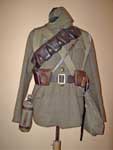

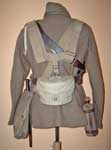 An early B.E. Patt. '03 set. All pieces are dated 1906 or before. The '16 dated tunic is buttoned to the QODY. Forage cap too, of a pattern peculiar to them, with a dark green top and band. (and not a dress cap). This distinction was also worn as a green band around the crown of a 1905 SD cap, or soft cap. The shoulder titles are MGC. Of` the two battalions of the QODY, one remained on home service as bicycle troops, the other was seconded to the MGC in France.
An early B.E. Patt. '03 set. All pieces are dated 1906 or before. The '16 dated tunic is buttoned to the QODY. Forage cap too, of a pattern peculiar to them, with a dark green top and band. (and not a dress cap). This distinction was also worn as a green band around the crown of a 1905 SD cap, or soft cap. The shoulder titles are MGC. Of` the two battalions of the QODY, one remained on home service as bicycle troops, the other was seconded to the MGC in France.
The Haversack shown in this set is particularly interesting. It is not the normal Haversack, G.S., Mk. I, usually seen with Patt. '03. Instead, it is an Officer's Private Purchase model.
Web Equipment Pattern 1908 - Pre-War Infantry

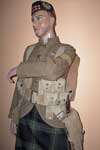


 Untouched since the war, this is an original 1909 and '10 dated set of Patt. '08 Web Equipment. Found in an officer's effects, with just the Haversack, Large pack, and Intrenching tool carrier added recently.
Untouched since the war, this is an original 1909 and '10 dated set of Patt. '08 Web Equipment. Found in an officer's effects, with just the Haversack, Large pack, and Intrenching tool carrier added recently.
In the British Army, the Bayonet frog was always worn to the rear of the left hip, not on the hip, as here. With Patt. '08, the Frog was more usually worn between the rear retaining band and rear "C" hooks.
The Service Dress Jacket, here for a Sergeant of the Gordon Highlanders, is as worn after 1918, as the full trio of Great War ribbons are being worn. During the War, only the ribbon of the 1914 Star existed. Of note is the first ribbon, a Military Medal and Bar. No Overseas Service chevrons are on his right cuff, which were authorised by Army Order No. 4, January 1918. They were discontinued by Army Order 434, November 1922, so the Jacket was being worn after this date.
Web Equipment Pattern 1908 - Pistol Order
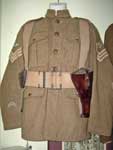
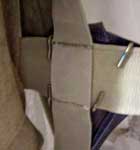
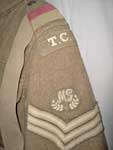
 Original wartime set with Braces sewn to Waist belt in lieu of Brace attachments. MGC marked. The Braces are dated 1910 and the Belt 1913. The Belt was originally a Belt, special, but the internal chapes have been removed.... obviously more comfortable this way!
Original wartime set with Braces sewn to Waist belt in lieu of Brace attachments. MGC marked. The Braces are dated 1910 and the Belt 1913. The Belt was originally a Belt, special, but the internal chapes have been removed.... obviously more comfortable this way!
Pistol rigs were contrived in various ways, when Brace Attachments were unavailable. The most simple doubled the Brace, around the Belt and back to itself, using the 2 inch sliding buckle. Other examples had 2 inch buckles, on chapes, stitched to the upper edge of the Belt.
The Service Dress Jacket belonged to a Sergeant of the Tank Corps, shown by the T.C. titles and the white rhomboidal tank arm badge. The shoulder strap colours of red and khaki indicate the 18th Bn., who were disbanded post-war. The Machine Gunner badge, normally worn on the left cuff, here denotes an Instructor, when worn above the rank chevrons. The two blue Overseas Service chevrons, on the right cuff, denote two years service after 1914. Had he seen service prior to 31st December 1914, the lower chevron would be red.
Infantry Equipment Pattern 1914 - Marching Order
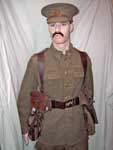
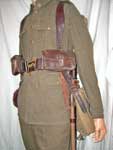
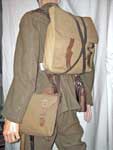 In this Patt. '14 Marching Order set both Packs, Frog, Helve holder and Cartridge pouches are early Service Brown. The rest of the set is in the later London Brown.
In this Patt. '14 Marching Order set both Packs, Frog, Helve holder and Cartridge pouches are early Service Brown. The rest of the set is in the later London Brown.
The Belt "diagonal straps" should be buckled to the base buckles on the Pack and then buckled again to the Straps, supporting pack. They have been left unfastened, as to have correctly fastened them would damage the leather.
Web Equipment Pattern 1937 - Early War Marching Order

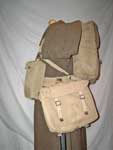
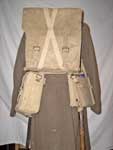
 W.E. Patt. 1937, Marching Order, displayed on a 1939 Pattern greatcoat. All of the webbing is 1939 dated and MECo marked.
W.E. Patt. 1937, Marching Order, displayed on a 1939 Pattern greatcoat. All of the webbing is 1939 dated and MECo marked.
Web Equipment Pattern 1937 - Mid War
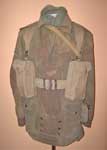

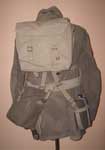
 Patt. '37 mid war set. Features Mk. II Basic pouches and a light pattern respirator, displayed on a 1st Pattern Denison.
Patt. '37 mid war set. Features Mk. II Basic pouches and a light pattern respirator, displayed on a 1st Pattern Denison.
Web Equipment Pattern 1937 - Late War
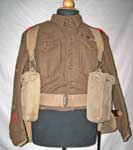
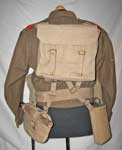 W.E. Patt. '37 late war set with many 'economy' features, including a Belt with web keepers, Pack without brass tabs, sheradized fittings, Mk. III Basic pouches with quick-release fasteners. On airborne Battle-Dress.
W.E. Patt. '37 late war set with many 'economy' features, including a Belt with web keepers, Pack without brass tabs, sheradized fittings, Mk. III Basic pouches with quick-release fasteners. On airborne Battle-Dress.
Web Equipment Pattern 1937 - Early War Officer's Equipment
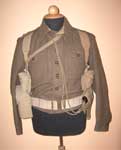


 Officer's Equipment, W.E. Patt. '37, on 1940 Pattern Battle dress. All of the webbing is 1939 dated and MECo marked. The Turk's Head on the Pistol Lanyard would normally be worn closer to the throat. Those serving on the North-West Frontier, for instance, moved the Lanyard to a shoulder, lest some wily Pathan garrott the wearer with it, either in action, or whilst sleeping!
Officer's Equipment, W.E. Patt. '37, on 1940 Pattern Battle dress. All of the webbing is 1939 dated and MECo marked. The Turk's Head on the Pistol Lanyard would normally be worn closer to the throat. Those serving on the North-West Frontier, for instance, moved the Lanyard to a shoulder, lest some wily Pathan garrott the wearer with it, either in action, or whilst sleeping!
Infantry Equipment Pattern 1939
This photo set has been transferred to the Patt. '39 Set Displays page.
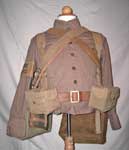
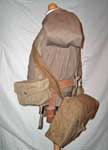
 Original "as-found" set of Home Guard web and leather equipment. Note the Sleeve, belt, web to attach the Patt. '37 Braces to the B.E. Patt. '03 Belt. The rubberised canvas Haversack (Home Guard pattern) had a sling with folded short sections. To increase its length, the stitching on one or more folds was cut. The water bottle is in a Carrier, water bottle (Home Guard pattern), which was the all-leather version of the Carrier, water bottle, O.S. When this latter was replaced by an all-web Carrier, the leather Carriers were transferred to the Home Guard.
Original "as-found" set of Home Guard web and leather equipment. Note the Sleeve, belt, web to attach the Patt. '37 Braces to the B.E. Patt. '03 Belt. The rubberised canvas Haversack (Home Guard pattern) had a sling with folded short sections. To increase its length, the stitching on one or more folds was cut. The water bottle is in a Carrier, water bottle (Home Guard pattern), which was the all-leather version of the Carrier, water bottle, O.S. When this latter was replaced by an all-web Carrier, the leather Carriers were transferred to the Home Guard.
The Braces are attached incorrectly, as they should be crossed in the normal manner. The B.E. Belt came with this basic set. However, it is a tight fit in the belt loops of Pouches, web, ammunition (Home Guard pattern). Doubtless some H.G. wore B.E. Belts and it's impossible to tell in photos, but there was a narrower Belt, waist, leather (H.G. pattern). The Frog is the correct Patt. '39 type, which carried U.S. M-1917 scabbard. This had no locket stud, the scabbard having an integrated hanger hook for use with U.S. M-1910 webbing. The plate that carried the hook, stopped the scabbard sliding through the Frog.
Web Equipment Pattern 1944 - Set for Rank and File

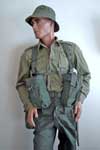
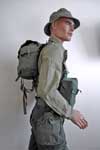
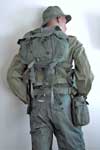 An OR's set of of early issue W.E. Patt. 1944, shown on a mannequin wearing a complete "jungle" uniform: Shirt, jungle, first pattern, dated 1944; Trousers jungle; Boots, jungle; Hat, jungle; Gaiters, jungle; all '45 dated. This is what the well dressed British soldier would have worn in the Asian theatre had the war continued into 1946.
An OR's set of of early issue W.E. Patt. 1944, shown on a mannequin wearing a complete "jungle" uniform: Shirt, jungle, first pattern, dated 1944; Trousers jungle; Boots, jungle; Hat, jungle; Gaiters, jungle; all '45 dated. This is what the well dressed British soldier would have worn in the Asian theatre had the war continued into 1946.
Mills Officer's Private Purchase Webbing Equipment
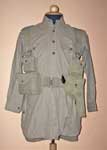
 Original matched 1936 dated set of Mills Commercial Officer's webbing. All items are marked to 6th Northumberland Fusiliers. Note the blanket straps to the rear of the Belt.
Original matched 1936 dated set of Mills Commercial Officer's webbing. All items are marked to 6th Northumberland Fusiliers. Note the blanket straps to the rear of the Belt.
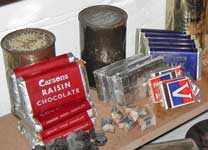
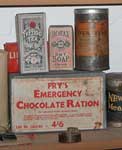
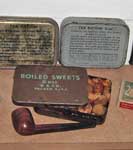 Ration packets and tins, chocolates, tea and tobacco. And more. All of the little extras Tommy Atkins needed in the trenches. Part of Chris's collection of original WWI & II pack fillers. Almost all of them are still full and unopened, although, as he points out, seriously past their "sell by" date!
Ration packets and tins, chocolates, tea and tobacco. And more. All of the little extras Tommy Atkins needed in the trenches. Part of Chris's collection of original WWI & II pack fillers. Almost all of them are still full and unopened, although, as he points out, seriously past their "sell by" date!

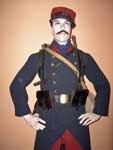
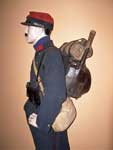
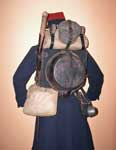
 Chris P's notes: Early French impression. This is a good insight into the gap in modernisation between the more or less Napoleonic French Poilu and the '08 equipped Brit. With the exception of the 1917 dated Linemann pattern tool, all items displayed here pre-date 1914, some as early as the 1880's and 90's. This represents a Poilu at the time of mobilisation in August '14. The patterns of uniform and equipment worn at this time date mainly from the 1860's to 1880's. Woefully unsuited to modern warfare, change had to come fast. New patterns of uniform were already planned by the outbreak of the war, and arrived hesitantly through the spring of 1915, in the new Horizon Blue. The leather equipment, although gradually modified and now brown, remained essentially unchanged to serve on into WW2.
Chris P's notes: Early French impression. This is a good insight into the gap in modernisation between the more or less Napoleonic French Poilu and the '08 equipped Brit. With the exception of the 1917 dated Linemann pattern tool, all items displayed here pre-date 1914, some as early as the 1880's and 90's. This represents a Poilu at the time of mobilisation in August '14. The patterns of uniform and equipment worn at this time date mainly from the 1860's to 1880's. Woefully unsuited to modern warfare, change had to come fast. New patterns of uniform were already planned by the outbreak of the war, and arrived hesitantly through the spring of 1915, in the new Horizon Blue. The leather equipment, although gradually modified and now brown, remained essentially unchanged to serve on into WW2.
A couple of points to note: The collars of the capote should bear the same regimental numbers as on the kepi, and on campaign a drab cover would have been worn on the kepi (I'm sure that made all the difference). Lastly, the moustache is circa 2008, genuine black mongrel tail hair. I enticed the business end with a large beef bone, & I'm sure she never noticed...


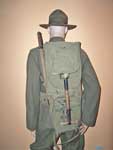
 Again, Chris P's notes:A display showing a 'Doughboy' circa 1916. Typical green colour and 'Eagle snap' fasteners of the early production Mills M1910 Web Equipment, this set dated 1915, with the exception of the Dressing pouch, of 1918 manufacturer. M1912 patterns of Campaign hat, Tunic & Semi - breeches. The colour of the hat cords denoting arm of service, this pale blue for infantry. M1905 Springfield bayonet in its second pattern (M1910 scabbard). Although the equipment was modern, there were many limitations; There was no haversack, the pack could carry no more than its designated load, and was complicated ...nor could it be worn separately. Likewise, the set had to be worn with the pack, as there were no separate braces.
Again, Chris P's notes:A display showing a 'Doughboy' circa 1916. Typical green colour and 'Eagle snap' fasteners of the early production Mills M1910 Web Equipment, this set dated 1915, with the exception of the Dressing pouch, of 1918 manufacturer. M1912 patterns of Campaign hat, Tunic & Semi - breeches. The colour of the hat cords denoting arm of service, this pale blue for infantry. M1905 Springfield bayonet in its second pattern (M1910 scabbard). Although the equipment was modern, there were many limitations; There was no haversack, the pack could carry no more than its designated load, and was complicated ...nor could it be worn separately. Likewise, the set had to be worn with the pack, as there were no separate braces.
Of particular note here are the 'Liberty' flashlight, M1902 canvas leggings and an early pair, with a 1912 contract date, of M1904 'Russet leather marching shoes'. These, and the leggings were immediately found to be woefully inadequate for the conditions in France, and replaced with the M1917 'Rough out' boots, M1917 gaiters or puttees . The M1917 gaiters saw service through WW2, & were copied almost exactly as Gaiters, Jungle, in 1944 as part of the new range of British equipment & uniforms.